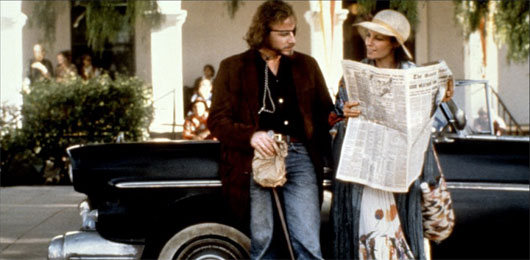
This 1961 French landmark drama is Peter Greenaways favourite film, and has also appeared in the list of worst films ever made. So which is it? European cutting-edge masterpiece or pretentious nonsense?
Well, its certainly a gorgeous-looking, very beautiful puzzle. Set in a beautiful country house with a clipped, precise garden, the plot revolves around a couple, X and A. He, X, keeps telling the beautiful A (Seyrig) how they met at the house last year, and have returned to decide whether to have an affair. She however remembers nothing of this, even though his decriptions of her clothes, hair and perfume are incredibly detailed.
Her husband meanwhile lurks around the shadows of the house and gardens, baffling people with a fiendish card trick in which he never seems to lose. He also seems to suspect something about X, and asks his wife what she has been doing all day.
The film is rightly famous for one shot in particular, of the various characters standing stock still in the garden with the sharp light throwing pin-sharp shadows on the grass of the manicured garden. It sums up the film formal, posed, self-knowing and baffling in equal measure. But what does it all mean?
There are several theories about what is going on here. Is A suffering from amnesia? Does X have some sort of wish fulfillment? Is he or she having some sort of elongated dream? Or is it all in the jealous husbands head? Whatever the answer, its an intriguing puzzle involving several techniques way ahead of its 1961 date over-exposure, grating music, different volumes, repeated lines of dialogue, cut-aways, long shots. Some viewers find it unbearable, some merely tedious, others a refreshing and unique experiment. Its certainly worth another look, and is another beautifully restored work from the BFI.
Overall verdict: Beautiful, baffling puzzle that is as dreamy as it is annoying.
Reviewer: Mike Martin
 Cinema in 1970s America produced some fine paranoid political thrillers The Parallax View, The Conversation, All The Presidents Men but this one seemed to get lost somehow. Perhaps it was timing it was actually released in 1981 or the fact that it opened to a disastrous New York Times review and was effectively buried. Maybe people were tired of hearing about Vietnam and feeling a collective guilt about their country. Rarely seen on British TV and only really known because of the presence of a young Jeff Bridges, its a real discovery to see this classic film on the big screen again.
Cinema in 1970s America produced some fine paranoid political thrillers The Parallax View, The Conversation, All The Presidents Men but this one seemed to get lost somehow. Perhaps it was timing it was actually released in 1981 or the fact that it opened to a disastrous New York Times review and was effectively buried. Maybe people were tired of hearing about Vietnam and feeling a collective guilt about their country. Rarely seen on British TV and only really known because of the presence of a young Jeff Bridges, its a real discovery to see this classic film on the big screen again.

 Charm a much under-rated quality in a film. Richard Ayoades directorial debut has it is buckets, and its actually very hard to pinpoint why. This coming of age story shies away from the cliché, the obvious and the cute, so much so that all the characters are pretty unlikeable, yet the film is consistently touching, very funny and occasionally moving.
Charm a much under-rated quality in a film. Richard Ayoades directorial debut has it is buckets, and its actually very hard to pinpoint why. This coming of age story shies away from the cliché, the obvious and the cute, so much so that all the characters are pretty unlikeable, yet the film is consistently touching, very funny and occasionally moving. Here’s a question that would be great to put to a round-table of professional filmmakers. Can a great action sequence ever work without context? Think about it, would the foyer shoot-out in The Matrix have worked if we didn’t know a) what Neo and Trinity were capable of, and b) what was at stake? What if the “spinning corridor” sequence in Inception had taken place in the first ten minutes of the film. Would it have the same impact? Would it have any? This question might seem like the minutiae of critical thinking, but here it is vital because it largely decides whether Sucker Punch is any good or not.
Here’s a question that would be great to put to a round-table of professional filmmakers. Can a great action sequence ever work without context? Think about it, would the foyer shoot-out in The Matrix have worked if we didn’t know a) what Neo and Trinity were capable of, and b) what was at stake? What if the “spinning corridor” sequence in Inception had taken place in the first ten minutes of the film. Would it have the same impact? Would it have any? This question might seem like the minutiae of critical thinking, but here it is vital because it largely decides whether Sucker Punch is any good or not.
You must be logged in to post a comment.